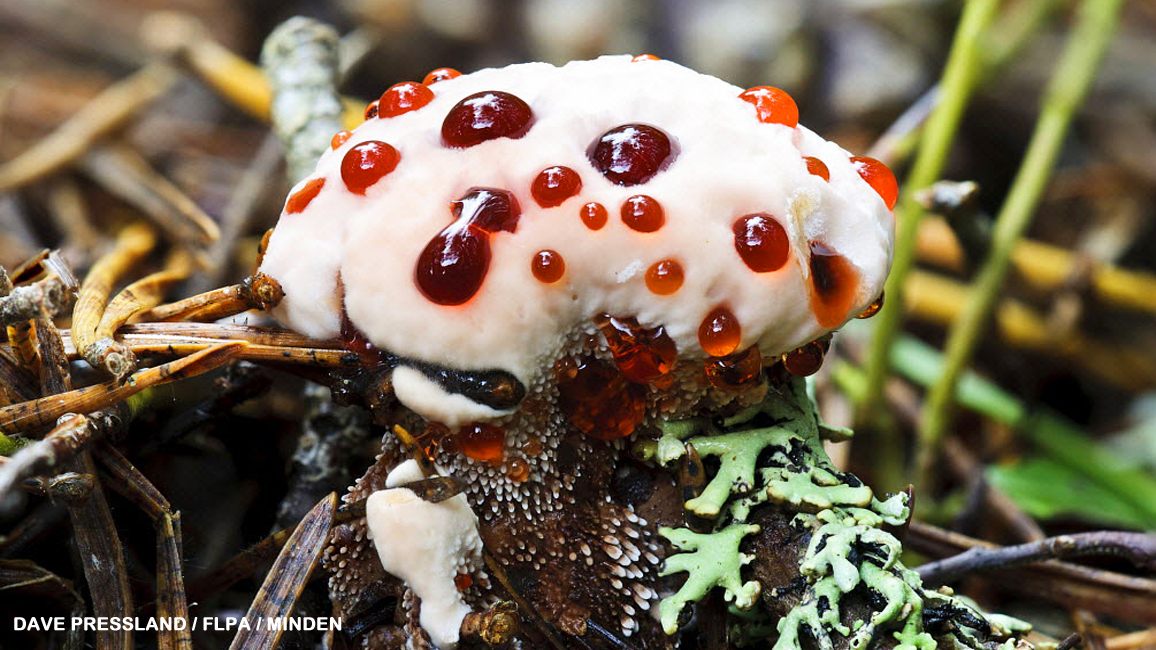
The Creepy Greenhouse
By Jennifer Bové; Art by Tom RichmondWell, well, look who’s here! Come in, Rangers, and let me introduce myself. I’m Dr. Acula Green—the world’s creepiest plant scientist. Check out the strange and disturbing things growing in my greenhouse—if you dare! Some are plants, and some are fungi (FUN-jye). And believe it or not, they are all real. As I tell my assistants, “Truth can be creepier than fiction!”

DEVIL’S TOOTH FUNGUS
It looks like this funky fungus was bitten by the sharp fangs of a forest-dwelling monster. But it’s not really bleeding. As the white-fleshed mushroom grows, it absorbs water from the soil until a gooey liquid oozes out. The red color comes from a substance inside the fungus. The devil’s tooth isn’t poisonous, but it is so bitter that no one would want to take a bite.
COBRA LILY
This “creep” is a kind of pitcher plant with a tube-shaped leaf that stands up like a cobra, ready to strike. It can’t bite, but it does eat living creatures. How? Sweet juice on its “forked tongue” attracts insects. When a bug crawls up the tasty tongue and walks along the rim of the tube’s opening, slippery stuff causes the insect to fall down into the tube. The insect lands in a pool of liquid, where it is digested—just as food is in your stomach.

STRANGLER FIG
Unlike most plants, the strangler fig grows downward. Here’s how it happens: A bird eats a fig fruit, then poops the seeds onto the branch of another tree. After one of the seeds sprouts, the roots begin growing down the tree trunk until they reach the ground. Once the fig is rooted in soil, the “web” of roots clinging to the trunk grows thicker and stronger. As the roots grow, they strangle the tree until it dies. The dead tree eventually rots, leaving the fig’s ghostly web of roots standing in its place.
RAFFLESIA
What is that terrible smell? It’s the world’s largest flower! The huge rafflesia (ruh-FLEE-zhuh) flower’s red petals look like raw meat, and its fragrance is fantastically foul. Some even say it smells like rotting flesh! While the stench might chase you away, flies are attracted to it. And flies help rafflesias reproduce by picking up powdery pollen from one flower and carrying it to another.
MEXICAN HAND TREE
Don’t be frightened—the monstrous red “hands” are flowers that fell from a special tree. The five-fingered blossoms appear in the spring, and, as they grow, the petals curl like creepy claws. The Mexican hand tree is not as spooky as it looks. In fact, native people of Central America once used its flowers in medicines to soothe pain. How handy!
VENUS’S FLYTRAP
Like the cobra lily, the Venus’s flytrap is a carnivorous (car-NIV-uh-rus) plant, which means it eats meat. When a fly or other insect touches tiny hairs on one of the plant’s two leaves, the leaves snap shut to trap the unlucky trespasser inside. After a few days of digestion, the leaves reopen. The empty outer shell of the insect falls out, and the flytrap is ready for its next meal.

DOLL’S EYE
Dangling from the red stalks of this dangerous plant are dozens of eyeballs! Just kidding—those “eyes” are white berries. But don’t even think about popping one in your mouth. Doll’s eye berries, leaves, stems, and roots are all poisonous to people. Touching them may burn and blister your skin! And eating them can cause dizziness, upset stomach, and even death. Strangely, the berries are safe for birds, mice, and squirrels to eat. These animals help spread doll’s eye plants by pooping out their seeds in new places.
OCTOPUS STINKHORN
Here is a freaky fungus that reaches out of the ground like the arms of a scaly, red octopus. It first appears on the forest floor as a white ball, almost like an egg. Then, as it grows, the egg-like fungus “hatches,” and the terrifying arms emerge! Although it looks scary (and is sickeningly stinky), the octopus stinkhorn is not poisonous. Care for a taste?
GIANT LOBELIA
Boo! If you were wandering around the misty mountains of eastern Africa, you might be spooked to see this hairy giant. It has spiky leaves and can grow up to nine feet tall. But the giant lobelia (loh-BEE-lee-yuh) is a monster only in size and is not at all harmful.
CORPSE FLOWER
What a nightmare! This beastly plant produces one of the world’s biggest and smelliest flowers. Scientists say that the chemicals that create the flower’s odor smell like a combination of rotting fish, old cheese, sweaty socks, garlic, and poop. The stench of this six-foot spike of blooms is strongest at night, so that’s when insects flock to the flowers in search of food. And as the insects travel from plant to plant, they helpfully spread pollen as they go.
So, Rangers, I hope you found my collection totally creepy. Maybe you’d like to help me dig up something else? . . . Hey, where are you going? Come back here!
















